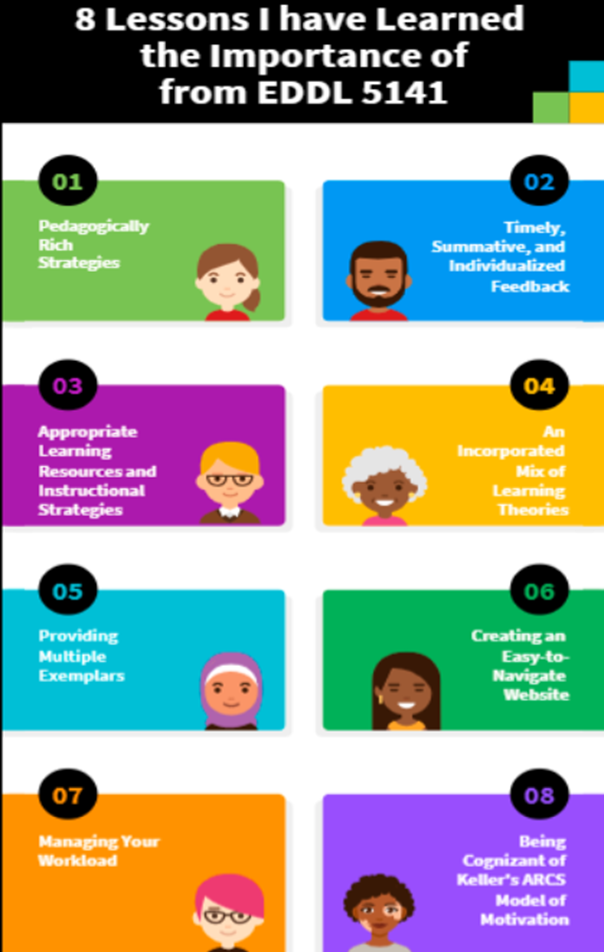Here are eight lessons I have learned the importance of from completing EDDL 5141 (described in more detail and easier to read!):
- The importance of utilizing pedagogically rich strategies such as:
- instructor interaction with students
- facilitating student collaboration
- continually monitoring and moderating discussions
Without these components, a student can feel isolated, unsupported, and left with an unfulfilling experience overall, and may become disengaged. Briggs (2015) proposes you can help to overcome these social barriers if you:
- Make contact with students before the course begins with a welcome email message
- Create an introductory activity so that students can get to know each other
- Provide opportunities for ongoing learner interaction
- Encourage sharing from learners. (Briggs, 2015)
- The importance of timely, summative, and individualized feedback from the instructor. The significance of quality feedback cannot be overstated; it is crucial for keeping students on track and guiding them in areas they need improvement. All too often, a student simply gets a grade or a mark on their assignment. If it was a piece of writing, why did it receive the grade? What was strong about the writing and what can the student do to improve it? These are crucial questions that students need answers to.
- The importance of developing appropriate learning resources and implementing instructional strategies. Without appropriate learning resources, some students would be over their head or conversely, not challenged enough. The appropriate instructional strategies are also important to push students and keep them engaged.
- The importance of combining elements from the various learning theories we have studied. Behaviourist elements would include learning outcomes for each module, sequenced material, and quizzes to assess understanding. Cognitivist element examples are different modes of presenting information like readings, visuals, and video, connecting content from a previous module to future modules, and chunking information to prevent overload. Constructivist elements are collaborative and reflective activities, with the opportunity for learners to have control over their learning process. Last, connectivist elements would include being open to a variety of students, networked learning, and the independence of the learners.
- The importance of providing multiple exemplars (i.e. what constitutes an “A” post, a “B” post, etc.). While this strategy alone is beneficial, having the students identify the positive and negative aspects of each exemplar is really important. This process helps students assess their own work and gives them a much better idea of what they need to do to improve their assignments. I have also learned about using a self-assessment strategy like a participation portfolio, where students submit their six best posts for grading, along with a description of what makes them their best posts.
- The benefits to a learner by creating a website with all readings and videos embedded on the pages. It really makes navigating through all of the activities a breeze, without having to do a lot of scrolling or jumping back and forth from multiple sites. I would include the estimated timing required to complete tasks along with the dates specific activities are due as well.
- The importance of managing your time, workload, and administrative duties as the instructor. This can be accomplished by setting boundaries with a clear schedule and home office hours, shorter and more frequent course interactions with students, and creating content ahead of time.
- The importance of integrating elements from Keller’s ARCS Model of Motivation to encourage and sustain learners. Capturing your students’ attention, ensuring activities are relevant, improving learner confidence, and providing a sense of satisfaction for your students are key components to consider.
References
Ally, M. (2008). Foundations of educational theory for online learning. In Anderson, T. (Ed.). The theory and practice of online learning (pp.15-44). Athabasca, AB: Athabasca University Press. Retrieved from “http://www.aupress.ca/books/120146/ebook/01_Anderson_2008-Theory_and_Practice_of_Online_Learning.pdf” \h
Briggs, A. (2015). Ten ways to overcome barriers to student engagement online . Retrieved from https://onlinelearningconsortium.org/news_item/ten-ways-overcome-barriers-student-engagement-online/
Dee Fink, L. (2003). A self-directed guide to designing courses for significant learning . Retrieved from http://www.deefinkandassociates.com/GuidetoCourseDesignAug05.pdf
Gagné, R. M. (1965). The conditions of learning and theory of instruction (1st ed.). New York, NY: Holt, Rinehart & Winston.
Keller, J. M. (1987). Development and use of the ARCS model of instructional design. Journal of instructional development , 10 (3), 2.
Salmon, G. (2006). 80:20 for e-moderators. In The challenge of ecompetence in academic staff development . CELT, NUI Galway, Galway, Republic of Ireland, pp. 145-154. Retrieved from https://eprints.usq.edu.au/18862/2/Salmon_Ch16_2006_PV.pdf


Leave a Reply
You must be logged in to post a comment.